Robert Millett meets the physios who treat patients with dangerous, highly infectious diseases.
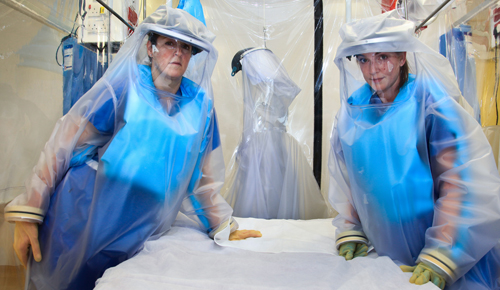
Specially trained physios Lauren Geddes and Suzie Murray in the Royal Free hospital’s high-level isolation unit in London. Photos: Joanne O'Brien
Conditions such as Ebola virus disease present an uncomfortable dilemma. Life-saving treatment is available, but providing it to a patient could prove deadly to health professionals.
Medical staff need to be protected before they can help. And the current crisis in west Africa has highlighted an urgent need for specialised treatment facilities and better resources in the countries
most affected.
In England physiotherapists are members of a select team trained to work in a protected environment which allows patients with highly contagious dangerous diseases to be safely treated.
The Royal Free hospital in north London houses the only high level isolation unit in the UK (though there area number of infectious diseases units in other centres).
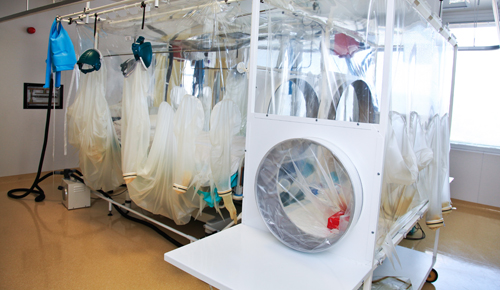
Equipment at the Royal Free's high level isolation unit
It opened in 2006 and is specifically designed to treat patients with virulent, infectious diseases. These include Ebola, Lassa fever, anthrax and Crimean–Congo hemorrhagic fever.
In the last eight years only four patients have been admitted to the unit. But despite being rarely used its specially trained staff remain on high alert. No one can predict when an emergency may arise, so staff receive regular training and the unit is always kept fully prepared.
Lauren Geddes, clinical lead for the hospital’s respiratory physiotherapy team, is part of the multidisciplinary team of trained staff who are called to duty as soon as any patient is admitted to the unit.
‘We don’t have patients in there very often but we are always in a state of readiness,’ she says.
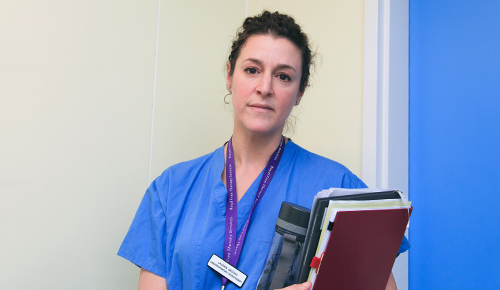
Staff working in the unit receive regular training
Behind locked doors the isolation unit contains two beds, both of which are enclosed by large plastic tents. Built into the sides of the tents are protective bodysuits, known as half-suits, which allow medical staff to interact safely with a patient inside.
The entire unit has controlled ventilation, and all staff have to pass through a one-way system of air locks to reach the main rooms. Each tent is also fitted to its own filtered ventilation system.
‘Patients are treated in a negatively pressurised chamber and all the air that circulates in and out is filtered through high efficiency particulate air filters,’ explains Mrs Geddes. ‘This prevents the release of infectious agents into the immediate environment and protects staff from direct contact with the patient.’
In addition, all the air leaving the unit is purified to ensure there is no risk to anyone at the hospital. All staff working in the unit receive a rolling training programme, with annual drills including a walk-through of all the processes involved, practical sessions with equipment and pretend admissions to the unit.
Extra training sessions are now taking place on a monthly basis, due to the recent Ebola outbreak in west Africa, and staff are being given revision videos to help maintain their skills.
‘The training is so good that any fears or anxieties, for example about cross contamination, are soon dispelled,’ says Mrs Geddes. ‘Every precaution is taken, and there are always experts on hand to advise you.’
Treatment challenges
When a patient admitted to the unit is acutely unwell, the respiratory physios’ primary function is to provide emergency treatment. ‘We are called in when they have overt respiratory symptoms, for instance if they are developing a chest infection, or if they are breathless or need more oxygen,’ says Mrs Geddes.
‘We treat them the same way as we would treat any other patient, in terms of the indications for therapy. But the challenge is the logistics of accessing the patient and the time it takes to get in and out of the unit.’
Mrs Geddes explains that she and her colleagues have to adhere to a strict and systematic protocol every time they enter or leave the unit.
This includes moving in a specified direction around the unit, changing into scrubs, special footwear and – when required – personal protective equipment.
‘It is possible to talk with a patient through the tent without getting into a suit but if any further interventions are required then we enter the isolation tent via the half-suits,’ says Mrs Geddes.
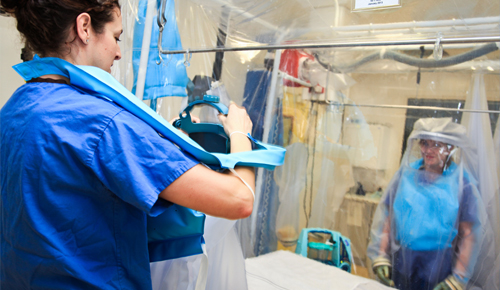
Mrs Geddes prepares to enter the isolation tent
During treatment physios in the unit are separated from the patient by the tent’s double-layered walls, but they are able to make contact via the half-suits’ gloves.
‘It is quite difficult not being able to physically touch and feel the patient in the same way that you would without the constraints of the tent or the suit,’ says Mrs Geddes. ‘And when you are working through two layers of plastic, everything is a bit harder to do.’
As well as dealing with respiratory problems, physios working on the unit also provide patients with rehab to combat any physical effects brought on by the isolation conditions.
‘These patients can be in a very confined space for a long period,’ says Mrs Geddes. ‘As a result they often develop secondary complications like blood clots, muscle wasting, weakness and deconditioning. So our role is also about trying to maintain the patient’s mobility and strength.’
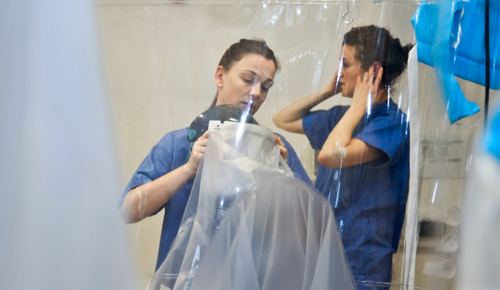
Physios follow a strict protocol when they enter or exit the unit
Physiotherapists provide the patients with bed-exercise programmes and pass equipment in to the tent for them to use. ‘Patients can stand up in the tent and there is enough room for a chair – so they can stand and walk on the spot, but not much more than that,’ says Mrs Geddes.
In the past the physiotherapists have provided isolated patients with small-scale equipment that has included resistance bands and an aerobic stepper.
‘We’ve also considered using a Wii fit,’ says Mrs Geddes. ‘But anything that’s put into the tent can’t be used again and even high cost items have to be destroyed once the patient’s treatment is over.’
Following any treatment or time spent in the unit staff must exit via a designated route and follow strict rules that ensure decontamination. The final stage involves showering and hair-washing before dressing again in normal uniforms.
‘It’s a time consuming process, and it can be complicated,’ says Mrs Geddes.
‘But everything has to be done in a certain order to make sure it’s safe and effective, and it does get easier with familiarity.’
As a result of all the stringent safety procedures a simple half hour assessment can take more than two hours, due to the time needed by staff to appropriately enter and exit the unit.
‘We aim to see the patients as frequently as clinically indicated, but in reality we can’t ever go in there to do a “quick check” or just decide to pop in to see how they are,’ says Mrs Geddes.
As a result the physios attend strategic multidisciplinary team planning meetings, which are held twice a day to discuss any unit patient. Based on these discussions informed decisions are made about how often the patient should receive physiotherapy and when treatment will next be required.
Guidance available
Although Mrs Geddes and her colleagues work in a specialised field she is keen to point out that all physiotherapists should be aware of the risks posed by contagious diseases.
‘We actually all treat patients with infectious diseases all the time – although the infections may not be as dramatic or newsworthy as the ones that we see here,’ she says.
‘All physios should be taught about universal precautions, because we never know what infections patients may have; so we should always be protecting ourselves.’
She suggests that every NHS trust should have an infection control team that can provide useful information. And private physios can easily access online advice from the World Health Organization or Public Health England.
‘It’s important that you keep yourself safe and keep the wider community safe by employing good infection control practices at all times,’ Mrs Geddes adds. ‘So if you do see a patient and suspect that something hasn’t been picked up then speak to an expert or a medic from an infectious disease team.’
Useful links
- Public Health England’s advice on the clinical management and guidance of Ebola
- Information from the World Health Organization on Ebola and occupational safety and health
- The Ebola outbreak: advice for physical therapists, from the World Confederation for Physical Therapy
- CSP information and links
Robert Millett
Number of subscribers: 1




































